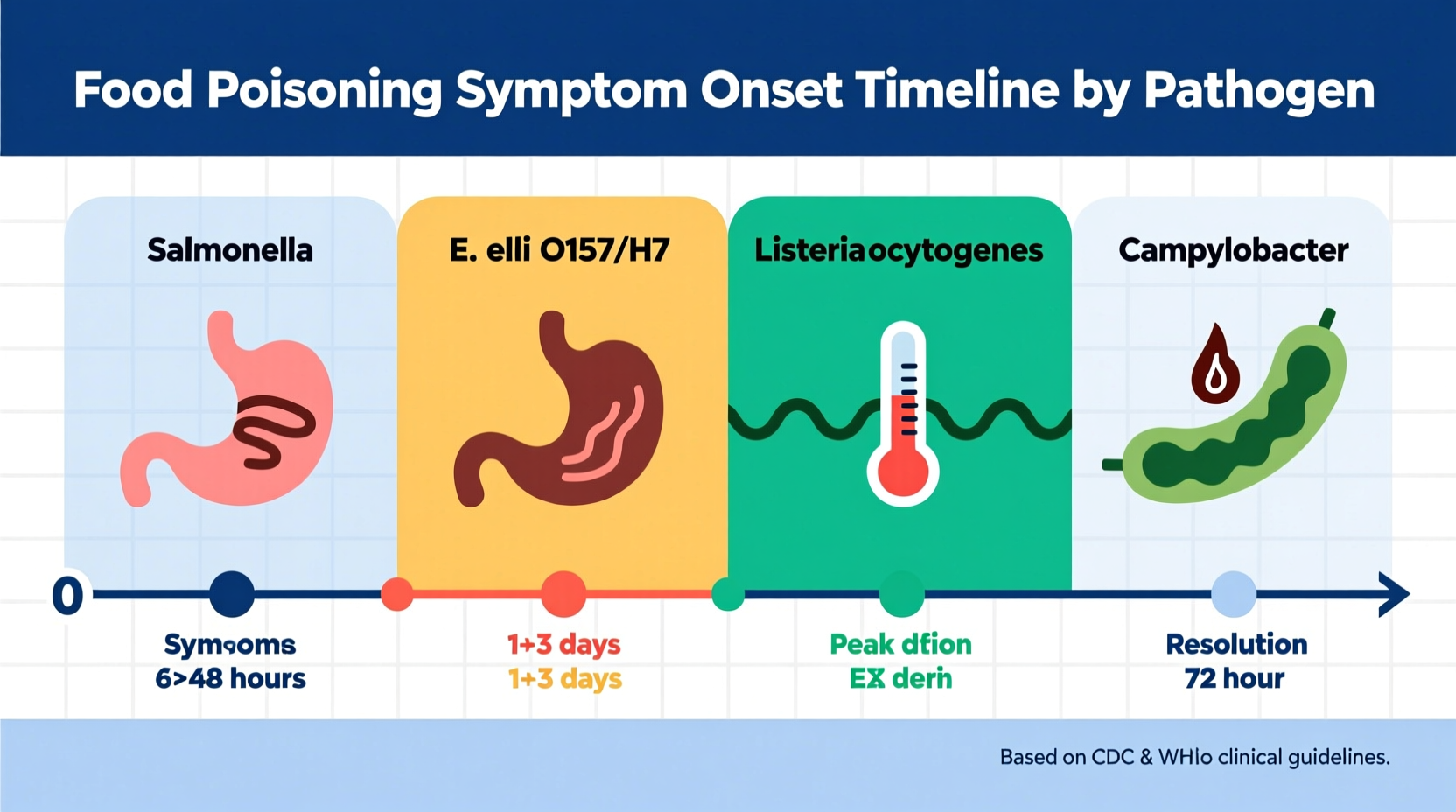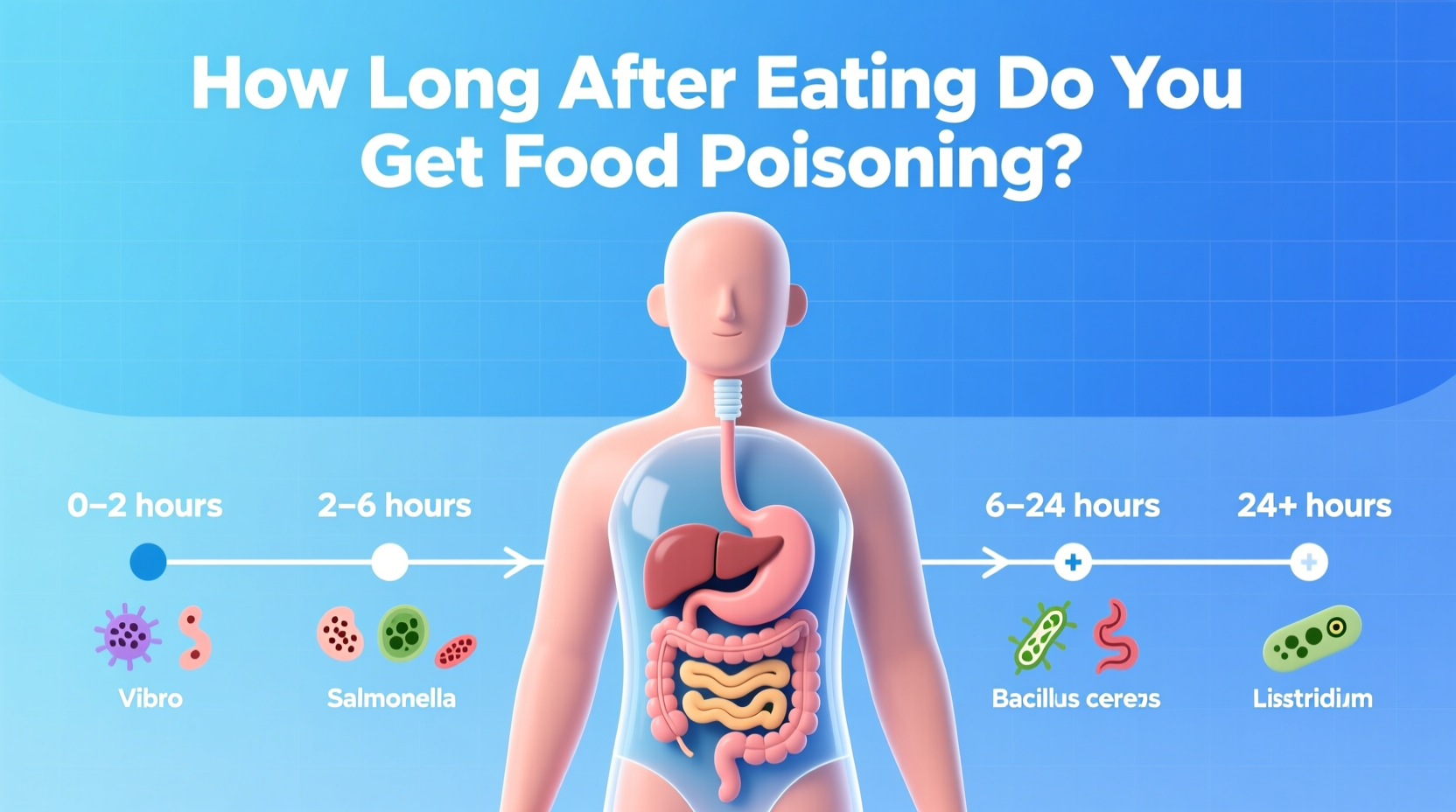Most food poisoning symptoms appear within 6 to 24 hours after eating contaminated food, but the exact timeframe varies significantly depending on the specific pathogen. Some types can cause symptoms in as little as 1 hour, while others may take up to 4 weeks to manifest.
Understanding when food poisoning symptoms typically appear can help you identify the source and determine if medical attention is needed. This comprehensive guide explains the timelines for different types of foodborne illnesses, factors that affect symptom onset, and crucial steps to take if you suspect food poisoning.
Food Poisoning Timeframes: What You Need to Know
When you're experiencing nausea, vomiting, or diarrhea after a meal, your immediate question is likely: "How long after eating do you get food poisoning?" The answer isn't straightforward because different pathogens have varying incubation periods—the time between consuming contaminated food and experiencing symptoms.
| Pathogen Type | Typical Onset Time | Common Sources |
|---|---|---|
| Staphylococcus aureus | 30 minutes to 8 hours | Deli meats, salads, pastries |
| Bacillus cereus (vomiting type) | 1 to 6 hours | Fried rice, other cooked rice dishes |
| Salmonella | 6 to 72 hours (usually 12-36) | Raw eggs, poultry, meat |
| E. coli (STEC) | 1 to 10 days (usually 3-4) | Undercooked ground beef, raw milk |
| Shigella | 1 to 2 days | Contaminated water, salads |
| Botulism | 12 to 36 hours (can be up to 10 days) | Improperly canned foods |
| Listeria | 1 to 4 weeks | Soft cheeses, deli meats, unpasteurized milk |
| Hepatitis A | 15 to 50 days (average 28) | Contaminated water, raw shellfish |
This comprehensive food poisoning onset timeline comes from the Centers for Disease Control and Prevention (CDC), which tracks foodborne illness patterns across the United States. The variation in onset times explains why pinpointing the exact source of contamination can be challenging.
Factors That Influence Food Poisoning Onset Time
Several elements affect how quickly food poisoning symptoms appear after consuming contaminated food:
Pathogen Type and Amount Consumed
Different bacteria, viruses, and parasites have unique biological mechanisms. Some produce toxins that cause immediate reactions (like Staphylococcus aureus), while others need time to multiply in your digestive system before causing symptoms (like Salmonella). The quantity of pathogens ingested also matters—larger amounts often lead to faster symptom onset.
Individual Health Factors
Your age, immune system strength, and overall health significantly impact symptom timing. According to the FDA Food Code, children, elderly individuals, and those with compromised immune systems may experience symptoms sooner and more severely than healthy adults.
Food Characteristics
The type of food consumed affects how quickly pathogens move through your system. Fatty foods slow digestion, potentially delaying symptom onset, while liquid foods may accelerate it. The pH level and water content of the food also influence pathogen survival and growth rates.

Recognizing Symptoms at Different Stages
Understanding the progression of food poisoning symptoms can help you determine appropriate actions:
Early Stage (Within 6 Hours)
Symptoms appearing within 6 hours typically indicate preformed toxins from bacteria like Staphylococcus aureus or Bacillus cereus. These often cause sudden, severe vomiting with minimal diarrhea. The World Health Organization notes that these types usually resolve within 24 hours without specific treatment.
Middle Stage (6-72 Hours)
This is the most common timeframe for food poisoning symptoms. You might experience:
- Nausea and vomiting
- Diarrhea (sometimes bloody)
- Abdominal cramps
- Fever and chills
- Headache and muscle aches
Most cases of Salmonella, E. coli, and Campylobacter fall into this category. Symptoms typically last 1-3 days but can persist longer in vulnerable populations.
Late Stage (3+ Days)
When symptoms appear more than 3 days after eating, they're often caused by pathogens like Listeria, Hepatitis A, or certain parasites. These may present with:
- Persistent diarrhea
- Jaundice (for Hepatitis A)
- Neurological symptoms (for severe Listeria cases)
- Longer duration of illness (up to several weeks)
When to Seek Medical Attention
While most food poisoning cases resolve on their own, certain symptoms require immediate medical care:
- Signs of severe dehydration (dry mouth, little or no urination, dizziness)
- Bloody vomit or stools
- Diarrhea lasting more than 3 days
- Fever above 102°F (38.9°C)
- Neurological symptoms like blurred vision or muscle weakness
- Symptoms in infants, elderly individuals, or those with compromised immune systems
The CDC reports that approximately 260,000 Americans require hospitalization each year due to foodborne illnesses. Early medical intervention can prevent complications, especially for high-risk populations.
Preventing Food Poisoning: Practical Steps
Understanding food poisoning timelines helps you identify potential sources, but prevention remains your best defense:
Follow the Four Core Practices
The FDA's Food Safety Education Program emphasizes four critical practices:
- Clean: Wash hands and surfaces frequently
- Separate: Avoid cross-contamination between raw and cooked foods
- Cook: Use a food thermometer to ensure proper internal temperatures
- Chill: Refrigerate perishable foods within 2 hours (1 hour if above 90°F)
Special Considerations for High-Risk Groups
Pregnant women, older adults, and immunocompromised individuals should take additional precautions:
- Avoid soft cheeses unless made with pasteurized milk
- Reheat deli meats until steaming hot
- Avoid raw or undercooked eggs, meat, and seafood
- Be cautious with sprouts and unpasteurized juices
What to Do If You Suspect Food Poisoning
If you believe you've consumed contaminated food, follow these steps:
- Stay hydrated: Sip clear fluids or oral rehydration solutions
- Rest: Allow your body to focus on recovery
- Track symptoms: Note onset time, duration, and severity
- Preserve evidence: Save any remaining suspect food for potential testing
- Report: Contact your local health department if multiple people are affected
Remember that antibiotics are rarely needed for most foodborne illnesses and may even be harmful for certain types like E. coli O157:H7. Always consult a healthcare provider before taking medication.
Recovering from Food Poisoning
Most people recover from food poisoning without complications, but the recovery process requires patience:
- Start with bland foods like toast, rice, and bananas once vomiting stops
- Avoid dairy, caffeine, alcohol, and fatty foods until fully recovered
- Gradually return to normal diet over 24-48 hours
- Practice good hygiene to prevent spreading illness to others
Complete recovery time varies based on the pathogen and individual health factors. While most cases resolve within 1-3 days, some may experience lingering digestive issues for weeks.











 浙公网安备
33010002000092号
浙公网安备
33010002000092号 浙B2-20120091-4
浙B2-20120091-4